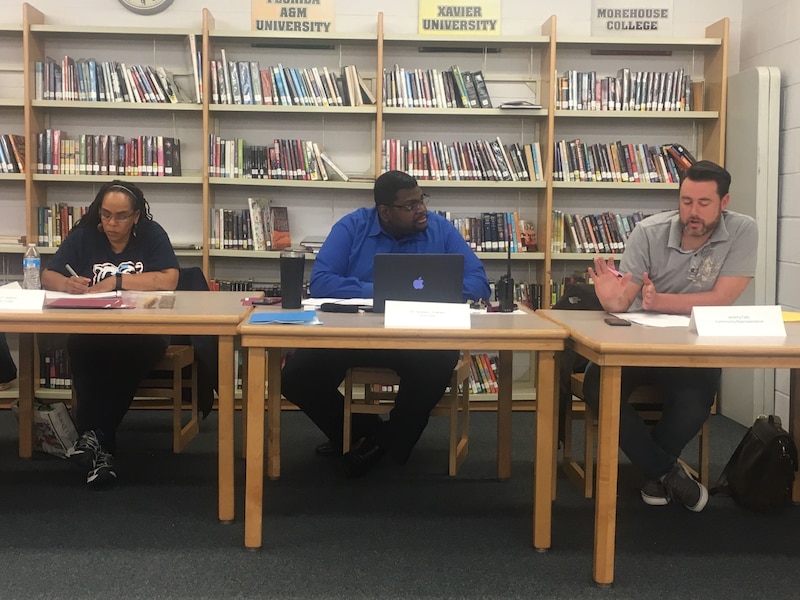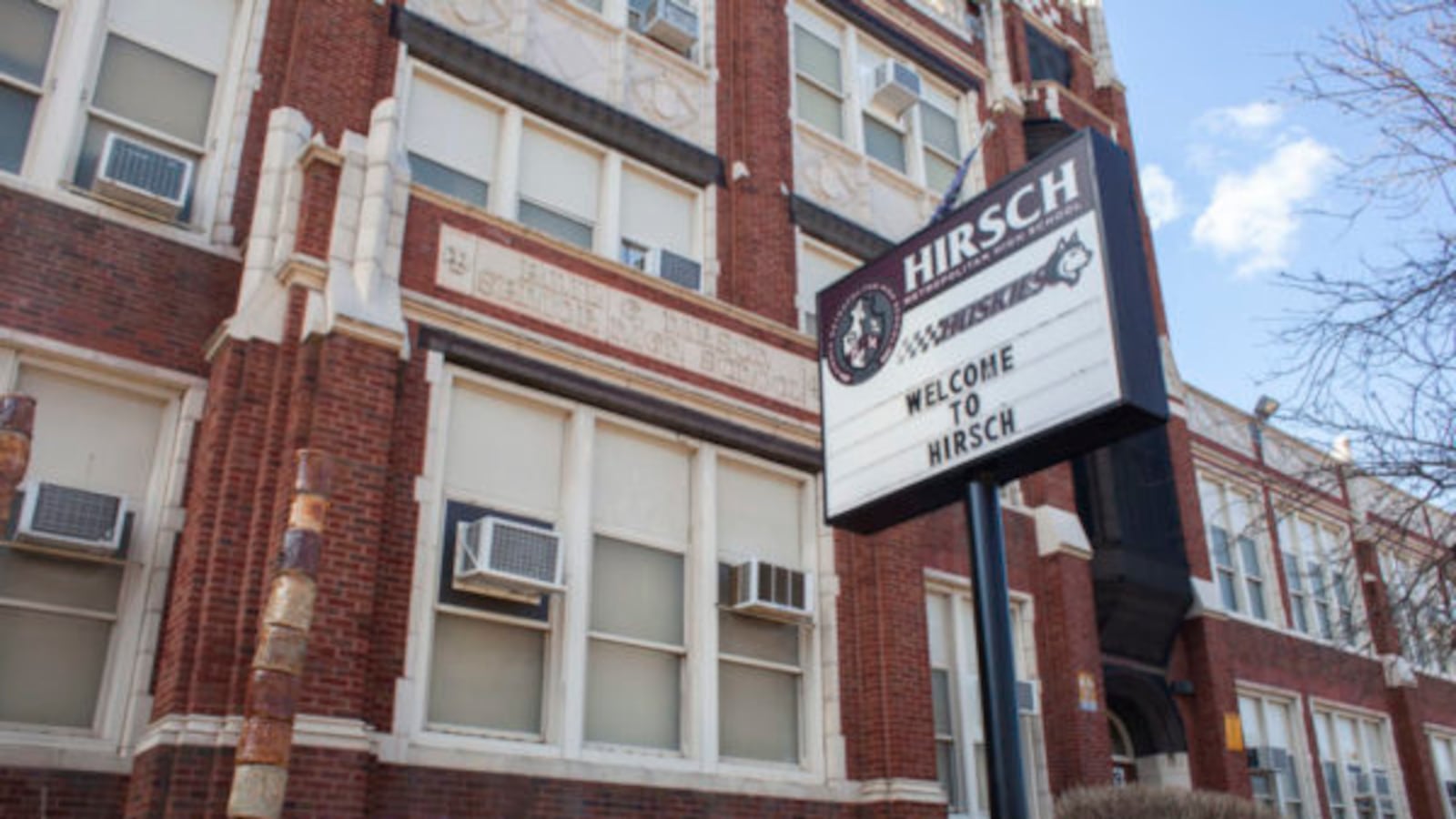Hirsch Metropolitan High School wanted to rebrand itself as the arts high school for a swath of South Side Chicago without one. Uplift Community High School, on the Far North Side, wanted to focus more on science, technology, engineering, and math.
Advocates for both schools, whose populations have shrunk by hundreds in the last decade, saw a chance at winning a five-year infusion of district funds to enhance course offerings as a way to boost enrollment.
But neither Hirsch nor Uplift got the award they sought from the nation’s third-largest school district. Now they puzzle over the quandary of how to deploy limited resources to attract more students and halt a downward slide that has landed shrinking schools on the budgetary chopping block.
Both campuses won a consolation prize of sorts that Chicago Public Schools offered some underenrolled campuses — $400,000 each in “equity grants” just for next school year to offset budget cuts triggered by declining enrollment. The district divided $31 million in grants between about 220 schools.
“The hope now,” said Sharon Adams, who heads Uplift’s Local School Council, “is that a long-term plan is coming.”
At Hirsch, a Level-2 school which enrolls only 3% of the 2,500 students who live in its Greater Grand Crossing and Auburn Gresham attendance boundaries, council member Maria Owens doubts the district’s help is enough to quell rumors that the district will soon shutter the predominantly black school, which serves about 100 students, nearly all of them from low-income families.
“Anything we get from the district we’re appreciative of, but it’s definitely not commensurate with our need,” Owens said. “I don’t feel there’s a vested interest in seeing Hirsch succeed — I think they want to leave us on life support, hoping that ultimately we stop bleeding and die.”
Related: Chicago schools look beyond closures to tackle declining student population
District spokesman Michael Passman discounted rumors of Hirsch’s demise.
“There’s no plan to close that school,” he said.
School district leaders tout the equity grants as a commitment to supporting rather than closing underenrolled schools, the vast majority of which serve majority black populations on the South and West sides. Uplift, a Level-2 rated school, serves a mostly black student population in diverse Uptown, one of the few North Side communities affected six years ago by Chicago’s mass school closings.
Related: Eve Ewing explains why some communities just can’t get over school closings
Laura LeMone, chief of Network 14, which includes Uplift, said that the equity grants will help avert more drastic cuts. But it’s not the only answer.
“I definitely think we need a small-schools strategy for schools that are under 250 students, and figure out how to support them,” Lemone said.
‘What can you offer me?’
Based on enrollment, rate of decline, and the grade levels served, Hirsch and Uplift are among 11 high schools awarded the maximum $400,000 in equity grants. The district awarded about $9.8 million to 35 district high schools. Even so, two-thirds of the grant recipients will end up with smaller budgets next year.
Related: In a shift, Chicago to prop up budgets at schools struggling to attract students
At Hirsch, which has lost an astonishing 85 percent of its enrollment since 2010, the grant offsets a $367,000 budget cut for next school year based on declining enrollment. That leaves little in the school’s $1.87 million budget for next school year to expand programs.
The school’s five-year graduation rate in 2018 was 45 percent, considerably lower than the district’s average of 78 percent. About half of Hirsch’s graduates in 2017 enrolled in college, a much lower percentage than the district average of nearly two-thirds.
Sophomore Anthony Sims, who selected Hirsch on the recommendation of relatives, said he’s had a good experience at the school and found negative rumors overblown.
“I’ve come across a lot of people who said they would go here if it wasn’t for the reputation it got,” Sims said standing outside the school Wednesday afternoon.
But he lamented the lack of special programs and suggested the school introduce vocational programs like culinary arts, mechanical engineering and manufacturing that prepare students for careers after graduation.
Parents agree on the need for a broader menu at the school. Hirsch only has a general education program and JROTC.
“When parents go to scout for a school for their kid,” Owens of the school council said, “the first question they have is: ‘What can you offer me?’”
She said the Local School Council has been busy exploring answers.
It has reached out to City Colleges of Chicago to arrange for students to take dual-credit classes that count for both high school and college credit. Owens said the council also is talking with Ald. Michelle Harris to seek outside funding for computer equipment to stock a new technology lab. The council plans to create a parent resource center, hopes to secure a full-time psychologist, and wants to shift to “progressive and forward thinking” discipline.
“We’re working on thinking outside the box,” said Owens, who has appeared at monthly school board meetings demanding more resources for Hirsch. “If the board will not give us the funds we need to progress, we’re going to have to be creative with seeking outside funding sources.”
The need to be more competitive is evident.
Related: In final stretch of recruitment season, Chicago high schools race to impress
Nearby Gary Comer College Prep enrolls nearly 400 of its 1,100 students from two ZIP codes that include Hirsch’s attendance area, according to district data. Comer offers 11 programs, including world language and international studies, fine and performing arts, and culinary arts and health careers, according to the school’s website.
Art in Motion Charter High School, operated by Distinctive Charter Schools and backed by the hip-hop artist and actor Common, plans to open a campus next fall within the Hirsch attendance boundaries.
Art in Motion will become what Hirsch had sought for itself: the first fine arts high school in that part of the city. Owens had hoped that an arts program would draw more students and also provide those with emotional and behavioral issues with healthy ways to express themselves.
The district acknowledged that many underenrolled schools need new programs and rebranding, and that the application process for them might have been difficult.
Passman, the district spokesman, said schools can try again for grants, and that the district is studying ways to provide more support during the application process.
‘We’re still fighting that battle’

Like Hirsch, Uplift has dedicated supporters and faces increasingly stiff competition.
Uplift, which accepts students from across the city and focuses heavily on social justice, sits in the attendance zone of Senn High School, a Level-1 school serving about 1,400 students in Edgewater. Senn was just awarded an International Baccalaureate Career Certificate program in the same application process that snubbed Uplift and Hirsch.
“There are a number of students who would default into Uplift who now are defaulting into Senn, and we certainly don’t have anything against Senn or anyone else, but we want this to be the neighborhood high school,” said Mark Kaplan, Uplift’s Community Sustainable Schools community coordinator.
It’s a designation the school has failed to win from the district. “The challenge is that as long as it isn’t the neighborhood school, it’s much harder to recruit students,” Kaplan said. “We’re still fighting that battle.”
Uplift’s five-year graduation rate last year was 65 percent in 2018. Of the previous year’s class, 61 percent enrolled in college.
Uplift allows students to take college-level courses at nearby Truman College, and offers career and technical education courses, including a teaching academy for aspiring educators. But it doesn’t have rigorous academic programs like International Baccalaureate or many Advanced Placement classes. The school suffers from a bad reputation, from what Kaplan called exaggerated rumors of violence in the school and real concerns about violence in the neighborhood.
At Uplift, where enrollment has dropped about 70% since 2009, the equity grant will compensate for half of an expected $800,000 enrollment-based cut next school year. That means the school will have to lean more heavily on its partner in a “Sustainable Community Schools” program won by the Chicago Teachers Union in its last round of contract negotiations, which pairs 20 schools with community organizations for school improvement efforts. Each project receives a $500,000 award.
Kuumba Lynx, an Uptown-based arts organization, is Uplift’s partner, and helps the school recruit students. It also helps integrate arts programming into the school’s curriculum, offers students summer jobs, and pays stipends for attending its after-school programs in dance, music production, poetry and theater.
The community schools initiative has helped Uplift build connections with nearby elementary schools, host a weekly family arts night and hold monthly parent meetings, Kaplan said.
Uptown’s alderman, James Cappleman has helped the school with its marketing and rebranding effort. He recently helped narrate a recent promotional video the school released in February.
At a school meeting in March, Uplift’s principal Tyrese Graham announced a partnership with Houghton Mifflin Harcourt and Truman College. Students will be able to earn college credit toward an associate degree in education, and explore career pathways via job shadowing and workshops. Parents can also attend workshops to help them support their children’s education.
Graham also said he’s developing partnerships with Northwestern University for student enrichment and teacher supports, and with Uptown Bikes on an attendance contest.
Junior Lourdes Abrom, 17, said she chose Uplift for its focus on social justice and enjoys discussions about everything from slavery and social movement leaders to police brutality. But she said the school needs more advanced placement courses and a broader menu of classes.
“Uplift has a positive message we’re trying to send,” she said. “I honestly think that if we had more resources and support we would be able to bring more students to our community.”
“There are still students enrolled at these schools”
Weathering declining birth rates, flat immigration rates, and an exodus of black families, Chicago has seen a dramatic drop in enrollment. It is expected to decline by 21,000 more students in three years. Chicago has seen the flight of black residents, who studies say are seeking better job opportunities, a lower cost of living, and safer neighborhoods than the segregated, often disinvested communities they hail from.
The city is not alone. Nationally, public school enrollment is expected to decrease 8% in the next decade.
Six years after Chicago closed 50 schools, mostly in black communities, fears of losing neighborhood schools remain high. After a five-year stay on closings, the city has begun closing four South Side high schools in the predominantly black Englewood community as part of a plan to build a new $85 million state-of-the-art high school. Although mayor-elect Lori Lightfoot has committed to a school closing moratorium, the problems that spurred the 2013 closings haven’t gone anywhere.
Related: Can a new high school heal years of school closings in Englewood?
The district emphasizes it is committed to maintaining all its campuses.
“Regardless of enrollment decline, there are students enrolled at those schools,” Chief Academic Officer LaTanya McDade said. “I think our focus shouldn’t be on closing schools sometime in the future — our focus should be on quality education today.”

